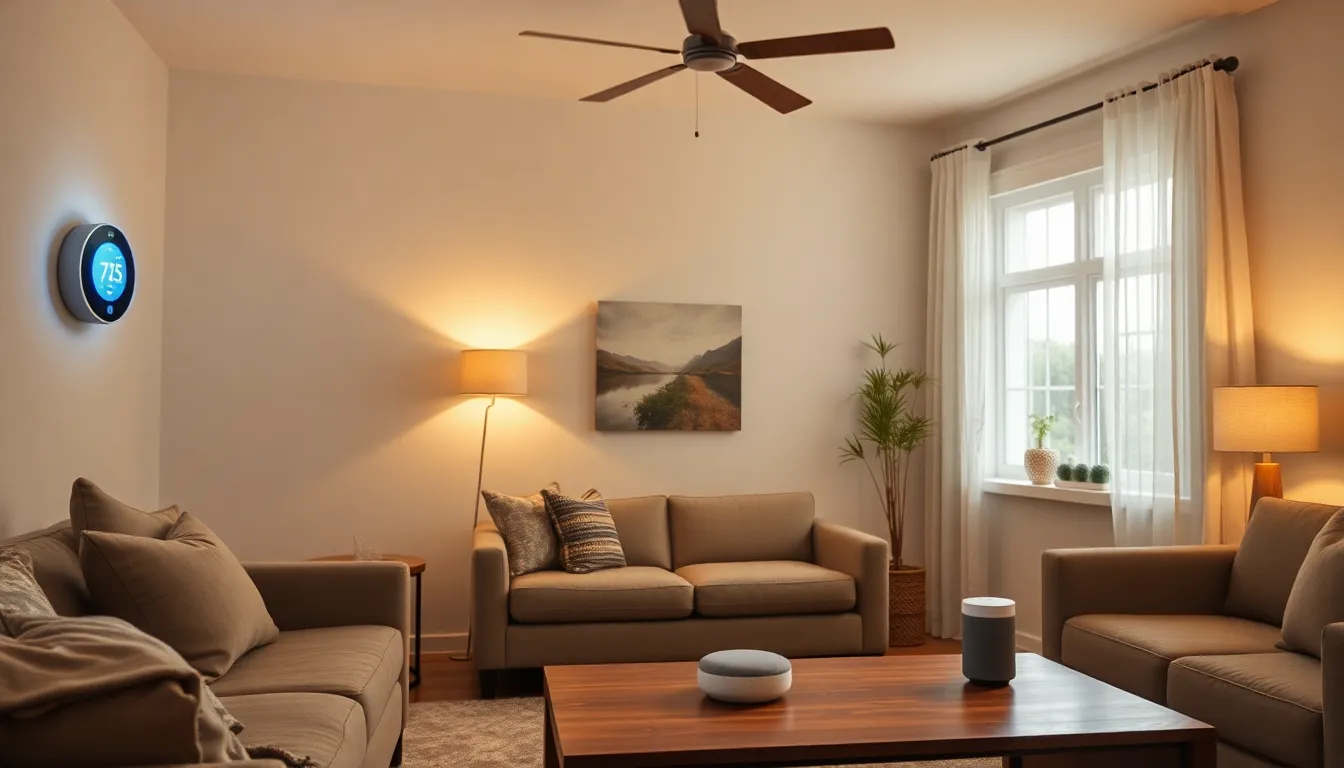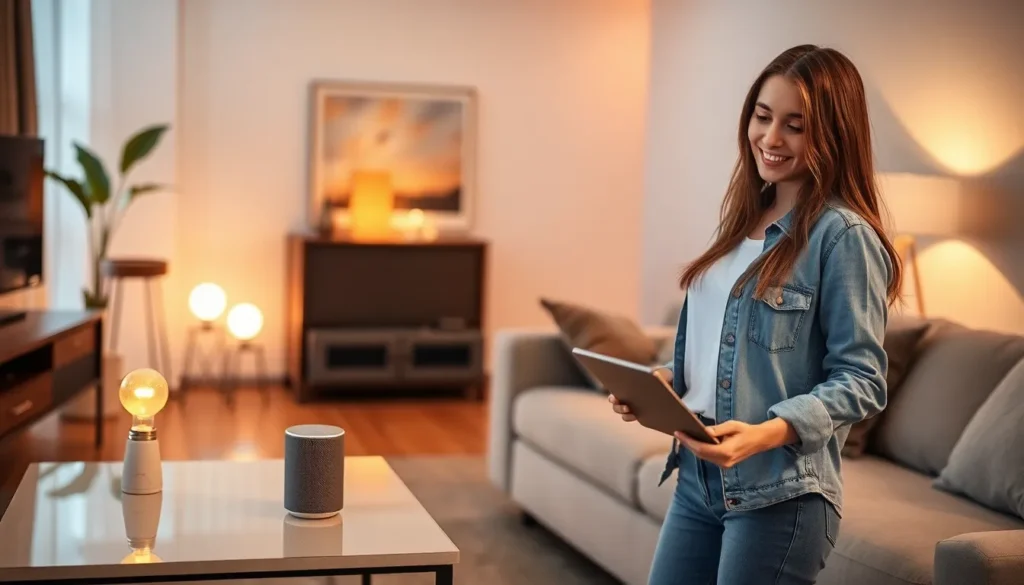Imagine waking up to the gentle hum of your coffee maker, while your smart thermostat adjusts the temperature to your liking—all without lifting a finger. Home automation devices are transforming everyday living into a seamless experience, making life not just easier but a bit more fun too. Who wouldn’t want to control their lights, security, and even their vacuum cleaner with just a simple voice command?
These gadgets are like the personal assistants we all wish we had—minus the awkward small talk. From smart speakers that play your favorite tunes to security cameras that keep an eye on things while you’re away, home automation offers convenience and peace of mind. Embrace the future of living and discover how these devices can turn your home into a smart sanctuary.
Table of Contents
ToggleOverview of Home Automation Devices
Home automation devices streamline daily tasks by integrating technology into everyday life. Smart lighting systems allow users to adjust brightness remotely or schedule operations. Devices like smart locks enhance security, enabling keyless entry through mobile apps.
Voice-activated assistants facilitate control over various connected appliances. Smart thermostats optimize energy usage, learning user preferences over time to maintain comfort efficiently. Sensors monitor environmental conditions, including smoke, carbon monoxide, or water leaks, providing alerts instantly.
Home automation hubs centralize control, allowing seamless communication between devices. Products like smart cameras offer real-time surveillance, enhancing home security while providing peace of mind. Smart speakers can play music, answer questions, or control other devices through simple voice commands.
Automated blinds and curtains enhance privacy and complement lighting, providing automated control based on the time of day. Home entertainment systems can synchronize for an immersive viewing experience, integrating multiple devices under one command platform.
Many devices support integration with existing systems, making them versatile options for any home. Support for popular platforms like Amazon Alexa, Google Assistant, and Apple HomeKit ensures compatibility with a wide range of gadgets. Home automation enhances comfort, efficiency, and security, transforming living spaces into modern sanctuaries.
Types of Home Automation Devices

Home automation devices come in various types, each designed to enhance functionality and convenience within living spaces. Here’s an overview of some key categories.
Smart Lighting Solutions
Smart lighting solutions provide users with control over illumination through mobile apps or voice commands. Adjustable brightness levels and color options allow for personalized atmospheres. These systems integrate with schedules, enabling automatic lighting based on user routines. Energy-efficient LED bulbs reduce electricity consumption, translating to lower utility bills. Adjustments can also occur remotely, increasing security by simulating occupancy when homeowners are away. Compatible with platforms like Amazon Alexa and Google Assistant, smart lighting simplifies life while enhancing home aesthetics.
Home Security Devices
Home security devices offer peace of mind through advanced monitoring capabilities. Smart cameras provide real-time video feeds, allowing users to monitor their property from anywhere. Motion detectors alert homeowners to unexpected movement, ensuring prompt responses. Smart locks eliminate the need for physical keys, facilitating keyless entry via mobile apps or codes. Systems can also integrate with alarms and sensors, creating a comprehensive security network. Notifications of security breaches appear instantly on smartphones, empowering users to act swiftly.
Smart Thermostats
Smart thermostats optimize energy consumption by learning user preferences and patterns. These devices automatically adjust temperature settings to maximize comfort while minimizing energy usage. Remote control features enable users to modify settings when they’re away, ensuring energy efficiency. Reports on energy usage provide insights into consumption patterns, guiding savings strategies. Integration with other smart home devices enhances overall control, allowing for synchronized adjustments to heating or cooling based on time of day or occupancy status.
Voice Assistants
Voice assistants enable convenient control over various home automation systems. Users can issue commands to adjust lighting, control temperature, or manage security devices. They respond instantly to questions or requests, enhancing the user experience with hands-free interaction. These assistants often integrate seamlessly with multiple devices, creating a cohesive smart home environment. Range of supported commands remains extensive, allowing users to customize their environments with ease. Compatibility with numerous platforms ensures flexibility and accessibility for all users.
Benefits of Home Automation Devices
Home automation devices provide numerous advantages, elevating daily living through improved functionality and ease of use.
Increased Efficiency and Convenience
Efficiency becomes a hallmark of home automation. Smart lighting systems let individuals adjust brightness with a simple command, saving time and effort. Automated routines streamline daily activities, like setting the coffee maker to start in the morning or locking doors remotely. Voice assistants enhance convenience, allowing for hands-free control of multiple devices. Personalized notifications ensure users remain informed about their home’s status, further simplifying management. A coordinated approach across devices facilitates a seamless user experience, maximizing daily productivity.
Enhanced Security Features
Security becomes a priority with advanced home automation features. Smart cameras offer real-time monitoring, providing instant alerts to potential threats. Keyless entry systems eliminate the need for physical keys, enhancing safety and ease of access for residents. Sensors detect unusual activities, triggering notifications that inform homeowners of potential risks. Integration with mobile devices allows for remote monitoring and control of security settings. These features render homeowners more aware and secure in their living environment while instilling peace of mind.
Energy Savings
Energy savings emerge as a significant benefit of home automation. Smart thermostats optimize heating and cooling by learning user habits, effectively reducing utility bills. Programmable lighting systems minimize energy consumption by turning off automatically when not in use. Incorporating energy-efficient devices provides greater control over consumption patterns. Monitoring energy usage in real-time leads to more informed decisions about energy habits. This proactive approach results in lower costs and promotes environmental sustainability.
Considerations Before Implementing Home Automation
Home automation introduces multiple considerations. Evaluating these factors ensures a smooth integration and enhances user experience.
Compatibility and Integration
Compatibility between devices remains crucial. Not all home automation devices work seamlessly together, so verifying whether new products are compatible with existing systems is essential. Many products support major platforms like Amazon Alexa and Google Assistant, facilitating interconnectivity. Integration simplifies control across various devices. Homeowners should check for software updates regularly to maintain device interoperability and enhance functionality.
Budget and Cost-effectiveness
Establishing a budget proves important in selecting home automation devices. Prices for devices vary significantly, depending on features and brands. Prioritizing essential devices helps manage costs effectively. Investing in energy-efficient options, like smart thermostats, may lead to long-term savings on utility bills. Considering installation costs, which can range from budget-friendly DIY to professional setups, plays a role in the overall expenditure. Assessing the total cost of ownership helps ensure a vital return on investment.
User Privacy and Data Security
User privacy and data security must be top priorities. Many devices collect personal information, making it crucial to understand the data management policies of manufacturers. Selecting devices with strong encryption protocols safeguards sensitive information from potential breaches. Homeowners should also change default passwords and implement two-factor authentication whenever possible. Regularly monitoring device access can help identify unauthorized activity and enhance overall security. Protecting personal data strengthens confidence in utilizing home automation systems.
Home automation devices are revolutionizing the way people interact with their living spaces. By integrating technology into everyday tasks, these devices not only enhance comfort but also promote energy efficiency and security. As homeowners embrace smart technology, they can enjoy the convenience of managing their environments through simple voice commands and automated routines.
With careful consideration of compatibility, budget, and privacy, individuals can create a seamless smart home experience. The future of home automation promises even greater innovations, making it an exciting time for anyone looking to upgrade their lifestyle. Embracing these advancements can transform a house into a modern sanctuary that prioritizes both comfort and security.





